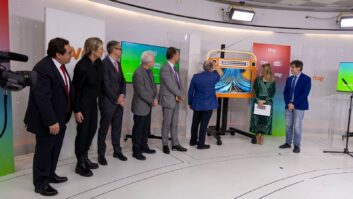IBOC is beginning to make inroads into Eastern Europe, as broadcasters and regulators learn more about the technology and explore the possibilities of multicasting to expand the number of available radio services for their multiethnic and diverse populations.
In Romania, a series of tests and demonstrations was conducted last fall in the northern Transylvanian city of Baia Mare to introduce HD Radio to the country, as George Pletea, radio manager for Romanian broadcasting group owner 2M Prima Telecom, noted at the NAB Broadcast Engineering Conference this spring.
After two years of planning and negotiations with the National Authority for Communications of Romania, an experimental authorization to test IBOC on 2M Prima Telecom’s Radio Impact station on 96.9 MHz in Baia Mare was granted in 2008.
At the IBC show in Amsterdam last September, arrangements were made with Nautel and the First Ukraine Broadcast Group to use a demonstration rack from the show floor for the Romanian tests before sending it to its permanent home in Ukraine. The rack contained a 1 kW V1 transmitter, M50 exciter, Importer, Exporter and processing equipment.
Although the main Radio Impact transmitter site on Mt. Gutai is an ideal location to cover Baia Mare and the surrounding area, according to Pletea, it posed problems as a test site due to its remote location and the lack of critical infrastructure such as sufficient STL bandwidth, a suitable test antenna and network connectivity. Instead, 2M Prima’s engineers decided to broadcast from an available two-bay top-mount antenna on a 200-foot tower near their studios.
That simplified the installation, operation and demonstration of the test station. Cooperative regulators modified the experimental license for the test station to allow broadcasts on a new frequency so that the 2M Prima station could continue operating on 96.9 MHz while the tests were underway.
One concern about the test antenna site was its relatively low height, and whether the digital signal would have enough power to provide reliable coverage over the approximately 90 square miles of the test area. After some testing of various power levels, engineers determined that only 90 watts ERP was required for digital reception with no dropouts throughout the area.
The tests culminated in a two-day demonstration in October for 75 attendees, including representatives from both of the Romanian broadcast regulatory agencies. One agency manages spectrum, the other approves programming.
Three channels were broadcast in the extended hybrid mode (48/48/24 kbps), and demonstration attendees were impressed with the sound quality and lack of multipath as they conducted drive tests, listening on JVC car receivers configured to tune the 100 kHz European FM channels properly.
The demonstration project appears to have had the desired effect, sparking interest among previously skeptical regulators, broadcasters and the listening public in the possibilities for digital radio broadcasting in Romania. Plans are now underway for a large-scale test in the Romanian capital city, Bucharest, and its 2 million inhabitants within the next year.
Brazil Tests Reveal Pros, Cons for IBOC
Brazilian broadcasters have been transmitting IBOC digital radio signals for several years, but until now there has been no comprehensive study of HD Radio system performance in the challenging propagation and allocations environment of South America’s largest and most populous country.
Ronald Barbosa is coordinator of the Brazilian Digital Radio Group for the Brazilian Broadcasting Association ABERT.
The digital radio group is an industry-led regulatory advisory panel similar to the digital radio broadcasting subcommittee of the National Radio Systems Committee. At the NAB BEC, Barbosa presented findings from an extensive field study of IBOC reception.
The study, sponsored by ABERT with a number of other broadcasting associations and station group owners, considered both AM and FM HD Radio system performance, with a particular focus on audio quality, coverage area, signal robustness and hybrid compatibility.
The test plan was developed in collaboration with the National Telecommunications Agency (Anatel), which had already developed operations guides and test procedures for both AM and FM IBOC stations, and with the Laboratory of Digital Radio and TV at Universidade Presbiteriana Mackenzie, which conducted most of the lab and field tests.
Two primary stations were selected for study in each band: a 100 kW-D/20 kW-N directional Class B at 1200 kHz in São Paulo and a 50 kW-D/5 kW-N directional Class B at 1150 kHz in Belo Horizonte for AM. For FM, they studied 60 kW/300m Class E3 stations on 96.9 MHz in São Paulo and 100.5 MHz in Ribeirão Preto.
To assess long-distance AM night coverage, an additional distant station, 100kW Class A on 600 kHz in Porto Alegre, was selected for spot nighttime measurements along the planned test routes. An experimental station on 90.5 MHz in Cordeirópolis was also constructed to evaluate low-power FM performance.
Field tests were conducted at a series of predetermined fixed points and radial routes, with data collected for digital signal status, analog signal status, signal field strength, noise levels on adjacent channels and audio sample recordings for subsequent subjective assessment. Additional testing of specific conditions was also conducted, including AM nighttime reception, indoor reception and low-power FM coverage.
In Barbosa’s assessment of the test results, he finds much to like about IBOC: FM and AM digital transmissions are very compatible with analog signals in the band, and audio quality is good even at low bit rates. He also finds that at low power, FM IBOC works better than expected and multipath interference resistance is much improved when compared with analog FM.
He notes, however, that there are still a number of areas where the HD Radio system could be improved: digital coverage is consistently less than analog coverage and indoor reception performance is widely variable. He notes that nighttime AM reception is problematic and the general robustness of the AM system needs to be increased.
Still, Barbosa concluded that the IBOC standard is a “good solution for Brazil, with the least impact for broadcasters and the general public” as stations transition to digital operation.
Antenna Construction Underway for Alaska DRM Tests
The experiment to see if an entire state can be covered by digital shortwave signals is slowly progressing, according to another NAB Show presentation.
Dr. Donald Messer, longtime shortwave broadcasting and Digital Radio Mondiale proponent, updated attendees about his plans to test DRM for an ambitious “local” shortwave service covering the state of Alaska.

Dr. Donald Messer discusses the Alaska DRM tests. Photo by Jim Peck With more than half of Alaska’s population concentrated around Anchorage and a few other urbanized areas, and the remainder widely distributed over a half-million square mile land mass, the state is one of the most sparsely populated areas in the world. This creates a challenging environment for the economics of FM and AM broadcasting, even before the harsh weather and limited accessibility of transmitter sites are considered.
The result is that many people throughout the state have limited or nonexistent access to broadcast radio.
Messer said three surplus 100 kW transmitters have been obtained from the Department of Defense and are now being tested into dummy loads in an underground mine near Fairbanks, and the first of three crossed half-wave dipole antennas has been constructed.
The test plan includes a series of experiments to determine what frequency bands and power levels are needed to provide reliable year-round service, as well as which combination of RF bandwidth, error correction and QAM constellation size provides the best balance of throughput and signal robustness from the DRM system.
Of particular interest is the nature of ionospheric propagation at high latitudes; providing statewide broadcast service requires a consistent and predictable “bounce back” of signals from the ionosphere and understanding the behavior of these reflections will require extensive experimentation, Messer notes.
To assist in the analysis of reception variability, a network of 18 remote receive sites will be set up around Alaska’s periphery to feed reception data back to the project headquarters in Fairbanks. Messer expects construction of the transmission system and remote receivers to be completed later this year. After that, a two-year data collection and experimentation project is planned.
Messer seemed careful not to sound over-optimistic that the system would work.












